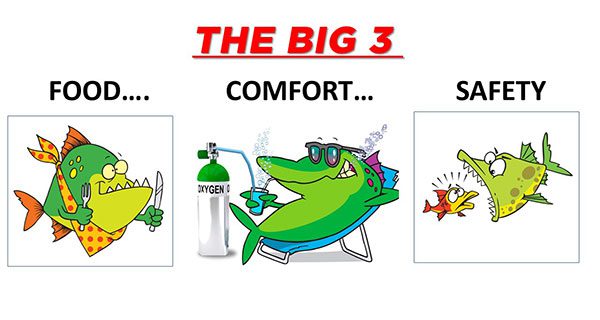
In the real estate world, the top three criteria most folks use for selecting their new home or business address are location…location…and location. When you think about it, the same is true for our piscatorial friends in both fresh and saltwater.
With perhaps the exception of the top predators, most fish base their location selection on the Big Three…Food, Comfort and Safety. Identify where all three of those factors converge and you’ve got a very fishy spot.
Game fish have to eat, and they have to eat often. A yellowfin tuna has to eat nearly its own weight in food every day, because it spends its entire life roaming the ocean currents. And that uses up a lot of energy. On the other hand, large trout will find a spot in a slip-stream behind a rock waiting for a tasty tidbit to float by. So your first task is to find the kitchen.
The next factor is Comfort. Fish will move both horizontally and vertically to find a location that is comfortable. Just like us, they have to breathe. Larger predators will find a place in the water column that has the right amount of dissolved oxygen. Ever notice how reservoir-based stripers will move to deeper water in the summertime? Sure the water is warmer at the surface than it is 50 feet down, but that warm water doesn’t hold as much oxygen as the cooler water does down deep. Fish are cold-blooded, and the actual temperature of the water may have less to do with preferred locations than the oxygen content. Water temperature is definitely a factor though, as evidenced by the old adage… “68 and the Fishin’s Great!”. Most of us have experienced the impact weather can have on the fishing. And changes in the barometric pressure, especially quick changes that occur with rapidly moving fronts can make a dramatic difference in the bite. As the front approaches, the bite can really fire up. And when the front arrives the fish may get lock-jaw for a couple days. I believe the change in pressure (which transfers into the water) can make fish either lethargic or frisky.
And the third factor is Safety. Why isn’t Safety the number one factor? Well if you are starving to death, or can’t breathe, being in a safe place doesn’t really matter does it? In reality, I’ve never been able to actually get a fish to tell me the correct order, even though I have interviewed a lot of them. So, let’s go with my supposition for the moment. Safety can come in the form of a good hiding place like a rock outcropping, or vertical structure such as pilings or ledges. Or it can be exhibited by large numbers like we see in schooling baitfish. The ability to blend into the environment or use camouflage is another trait that provides safety from being eaten by something larger. Similarly, predator fish use those same techniques for finding food. Starting to see a pattern?
Inland lakes, coastal waters, and even a mountain trout stream will usually have places that provide at least two out of the three factors. During certain times of the year, you’ll find a spot that has all three. And to find these spots, modern technology has provided us anglers with an assortment of tools. Detailed charts will show ledges and drop-off’s, structure, creek channels, bottom composition and more. There are temperature probes to see the water temp down where the fish are…remember the water temperature on your sonar unit only shows the temperature at the surface. It could be 5 to 25 degrees cooler down below.
Picking the most suitable location to make a homestead is as important to fish as it is to us two-legged critters. If you keep that in mind as you make your selection on where to fish, and in many cases…how to fish, you’ll find your days will become more and more productive. So find a location that has the Big Three… Food, Comfort and Safety and you’ll be well on your way to closing the sale on some fine fishing.
Tight lines and calm seas.